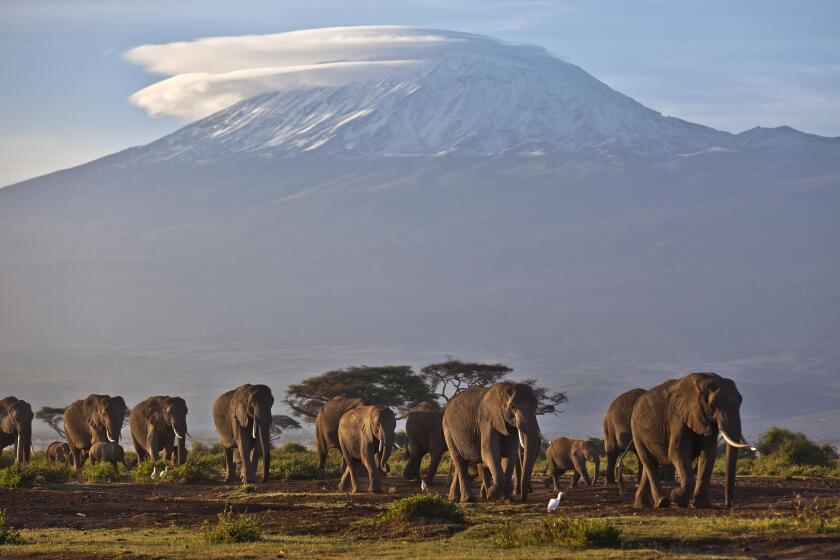African nations plant mangroves to counter effects of climate change

- Share via
MOMBASA, Kenya — In a bid to protect coastal communities from climate change and encourage investment, African nations are increasingly turning to mangrove restoration projects, with Mozambique becoming the latest addition to the growing list of countries with large-scale mangrove initiatives.
Mozambique follows efforts across the continent — including in Kenya, Madagascar, Gambia and Senegal — and its initiative is touted as the world’s largest coastal or marine ecosystem carbon storage project. Known as blue carbon, carbon captured by these ecosystems can sequester, or remove, carbon dioxide from the atmosphere at a faster rate than forests, despite being smaller in size.
Mozambique’s mangrove restoration project — announced in February alongside its United Arab Emirates-based partner, Blue Forest — hopes to turn 185,000 hectares (457,100 acres) in the central Zambezia and southern Sofala provinces into a forest that could capture up to 500,000 tons of carbon dioxide, according to project leaders.
“Blue carbon can be utilized not only to sequester tons of carbon dioxide but to also improve the lives of coastal communities,” Vahid Fotuhi, the chief executive of Blue Forest, told the Associated Press. “There are around 1 million hectares of mangrove forests in Africa. Collectively they’re able to sequester more carbon dioxide than the total annual emissions of a country like Croatia or Bolivia.” He added these projects would create green jobs and promote biodiversity.
Africa’s major mangrove forests have been decimated in recent decades due to logging, fish farming, coastal development and pollution, leading to increased blue carbon emissions and greater exposure of vulnerable coastal communities to flooding and other threats to livelihood.
Global heating is having dire effects on people and nature, the U.N. says, with urgent action needed to curb emissions and adapt to worsening effects.
But the continent’s growing focus on mangrove restoration can be attributed in part to the successful Mikoko Pamoja project, initiated in 2013 in Kenya’s Gazi Bay, which protected 117 hectares of mangrove forest and replanted 4,000 trees annually, spurring other countries to also address their damaged coastal land and re-create its success.
The group Mikoko Pamoja, Swahili for “mangroves together,” centered its efforts on protecting the small communities in Gazi and Makongeni villages from coastal erosion, loss of fish and climate change. It was dubbed the “world’s first blue carbon project” and earned the community of 6,000 residents global fame, accolades, carbon cash and greater living standards.
“Mikoko Pamoja has led to development of projects in the community, including installation of water,” said Iddi Bomani, the village chair of the Gazi community. “Everyone has water available in their houses.”
“It especially leads to improved livelihoods through job creation when done by communities,” said Laitani Suleiman, a Mikoko Pamoja committee member.
Africa’s rare glaciers, such as the one on Mt. Kilimanjaro, will disappear in the next two decades because of climate change, a new report warns.
Several other projects have come to fruition since. In Senegal, 79 million replanted mangrove trees are projected to store 500,000 tons of carbon over the next 20 years. Neighboring Gambia launched a reforestation effort in 2017, with Madagascar following suit with a preservation project two years later. Egypt is planning its mangrove restoration project ahead of hosting the United Nations climate conference in November.
The projects have sparked a clamor for the sale of carbon credits, a type of permit that allows for a certain amount of emissions as remuneration for forest restoration or other carbon offset projects. Gabon was offered a recent pay package of $17 million through the Central African Forest Initiative for its protection efforts, but complaints persist on the low prices offered to African governments.
“Africa remains excluded from a lot of financing available under climate change,” said Jean Paul Adam, head of the climate division at the Economic Commission for Africa, adding that a lack of financing means nations on the continent are unable to build up their resilience to climate change.
As climate change has heightened concerns about the global decline of mangroves, a study released this week found that such ecosystems along the desert coast of Baja California may be more important than previously thought for keeping heat-trapping carbon dioxide out of the atmosphere.
He said that “nature-based solutions and advocating for a fair development price of carbon” would propel the African economy.
And the benefits of reforestation can be significant, according to Coral Reef Alliance’s Marissa Stein.
“Restoring and protecting our marine habitats plays a key role in maintaining the health of our planet,” she said, adding that mangroves alone store up to four times more carbon per hectare than tropical rainforests. The Global Mangroves Alliance estimates that mangroves also reduce damage and flood risk for 15 million people and can prevent more than $65 billion of property damage each year.
More to Read
Sign up for Essential California
The most important California stories and recommendations in your inbox every morning.
You may occasionally receive promotional content from the Los Angeles Times.
















